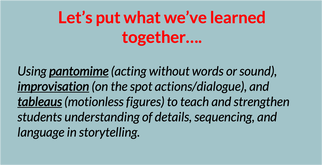|
By: Theresa Andersen  Art instruction helps students from pre-K to high school with their development and growth of motor skills, language skills, social skills, decision-making, risk-taking, and inventiveness. The arts are for all learners, at all levels. Students connect with their own culture as well as the wider world. Art allows us to examine what it means to be human, to voice and express, and bring people and ideas together. The arts remind us that we are not alone and that we share a universal human experience. We can feel deep emotions together and are able to process experiences, find connections and create impact.  This spring, the Fordham PDRC invited Gia Bonavita, a LEAP* artist to facilitate six webinars that focused on Storytelling through Theater Arts and the use of Visual Thinking Strategies (VTS) to model for participating educators how to use the performing arts to foster students speaking, listening and overall communication skills development while bringing them closer through movement. Gia’s dynamic personality brought the engagement of participants and encourage them to share ideas in their classrooms, both in-person and online. During the first webinar, we were introduced to three teaching strategies that teach and/or strengthen students’ comprehension of imagery, point of view, and characterization to create and bring stories to life. Pantomime: In this activity participants had to tell a story using bodily expressions, facial movements and/or gestures but no words. Being virtual made it a challenge, but the group had a fun time doing it as Gia guided and started us in our performance. Improvisation: When doing improvisation, we depended on one another. Gia would start a dialogue and we each had to add a line to create a whole scene. To say the laughter from the lines shared to create a story was a welcomed part of a long day after teaching. Tableau: This strategy by definition, depends on a group of motionless figures representing a scene from a story. It was not an easy task, but participants were very responsive and voiced how they could see this as a possibility in their classrooms. As participants, we were immediately engaged, relating to one another, laughing, sharing and realizing that what we were experiencing would be a wonderful way for children to experience the arts while they were learning and sharpening their literacy skills, all while having fun. The participants in this series were very positive in their survey comments- “It was a great presentation. It was engaging and I had so much fun acting out. Thank you! It was so much fun after a long day. I will implement some of these strategies in my daily teaching routine to all my students.” The next set of webinars focused on using Visual Thinking Strategies (VTS) that had us look at pieces of art and answer a series of questions that Gia facilitated and led the discussion that naturally followed from the questions. What a wonderful way to get students to feel more confident and empowered because there are no wrong answers. Students get to think beyond what they would have, if they read something by studying a work of art and actually they get to think deeper. These VTS enhance visual, oral and written literacy skills and produce growth in all types of students- from ELL students, to those with learning disabilities, to those higher achievers. VTS was developed by Abigail Housen, a cognitive psychologist over 20 years ago. “We have come to believe that discussions of art may be the most fertile grounds for teaching critical thinking skills precisely because there is no one right answer.” Gia demonstrated this by having the participants study a number of works of art and as adults we were amazed at what someone saw that we did not even think of. Imagine what children would see if given the chance and how their world would open to deep discussions.  The arts give personal and social benefits to both students and adults. We should rely on the arts to help us through difficult times. Gia gave us much to think about and work with. We are looking forward to having Gia join us in the fall so we can offer webinars that show just how important the arts are to all students, enhancing their education. *LEAP is an educational arts program that promotes access and equity for NYC students underserved in the arts. Gia is a member of SAG-AFTRA with more than 20 years experience in theatre arts education.
0 Comments
Your comment will be posted after it is approved.
Leave a Reply. |
Archives
January 2024
Categories
All
|

